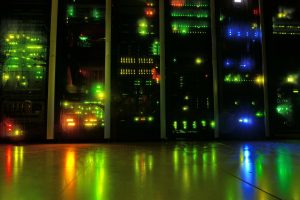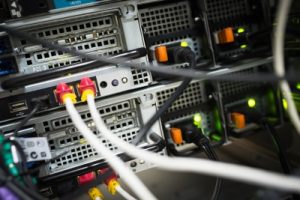
Knowledge Base / News
Monitoring your data center is critical to maintaining maximum uptime. Whether your data center’s primary purpose is to support your organization, or you are hosting servers and services for your clients, any downtime you experience will lead to a loss of revenue and customer confidence.
DCIM tools have become an integral part of helping organizations maintain data center uptime. Software and hardware working together to monitor conditions, power usage, bandwidth availability, physical space use, and more help you keep a close eye on your data center.
One of the major factors to potential data center downtime is environmental conditions, including temperature, humidity, and water leaks. If your DCIM solution doesn’t involve full environment monitoring, you may be missing critical conditions that can bring down your data center in a heartbeat.
 DCIM helps organizations gather data and information on their data center to help organize information on services, data stored, hardware capacity, facility availability, and so much more.
DCIM helps organizations gather data and information on their data center to help organize information on services, data stored, hardware capacity, facility availability, and so much more.
Typically, DCIM tools are used by larger organizations that have multiple data centers that form the base of their entire operations. They can sometimes be costly in terms of pricing as well as the time needed to set up and manage them. There are some smaller packages that do offer many useful data points to help organizations with only a single data center manage their facility, and they can be extremely beneficial.
Knowing what resources are in use vs. what resources are available is an important part of DCIM applications, especially in an environment that’s constantly growing and changing. Viewing reports and data on power consumption can help determine whether or not it’s viable to introduce more servers without power upgrades, for instance. Likewise with potentially bandwidth-intensive services or clients – DCIM helps provide information on whether or not the current internet connectivity can support adding to the data center.
Many newer network appliances come prepared to interface with DCIM systems fresh out of the box. Due to their easy setup, a good number of organizations will integrate them immediately and assume that they are receiving the best monitoring data as possible.
PDUs fit into this category, as many will provide power monitoring as part of their overall power distribution and management duties. Some PDUs also come with temperature monitoring as well, which add to their value.
One concern with relying on PDUs for environment monitoring involves their location; while monitoring temperatures at the back of your rack or cabinet is definitely recommended, the areas they monitor tend to be restricted in size. Having a full scope of the temperatures within your data center, such as at HVAC vents, smaller equipment closets, or near entrances, aren’t typically covered by PDU monitoring capabilities.
Additionally, humidity can be just as much a concern within data centers and server rooms. Monitoring humidity, dew point, and relative humidity are also crucial to providing a safe environment for both sensitive electronics as well as employees. Monitoring humidity trends can also help identify other issues, such as HVAC failure, before they happen, allowing your organization to enact preventive maintenance.
 Integrating PDUs into your DCIM solution is always a good idea, and enhancing environment monitoring with a dedicated environmental monitor is an even better idea. Environment monitors are expressly provided to focus on environment factors such as temperature, humidity, water detection, smoke, and much more. Many of those factors aren’t monitored by “smart” devices, and a gap in your DCIM solution could prove incredibly costly.
Integrating PDUs into your DCIM solution is always a good idea, and enhancing environment monitoring with a dedicated environmental monitor is an even better idea. Environment monitors are expressly provided to focus on environment factors such as temperature, humidity, water detection, smoke, and much more. Many of those factors aren’t monitored by “smart” devices, and a gap in your DCIM solution could prove incredibly costly.
Water detection in your data center is a must-have to protect your investment. Being alerted immediately when water is detected due to a burst pipe, roof leak, construction accident, or any other unexpected cause can mean the difference between spending time to mitigate the issue, and spending time wondering when your data center will be back online.
Advanced temperature monitoring should be factored into your DCIM as well. Placing sensors throughout the facility, not just at the back of hot aisles, will allow you to better understand the environment within your data center or server room. Tracking temperature fluctuations over time will not only give you the peace of mind in knowing that your facility is protected, it can also save your organization money spent on cooling and heating. Identifying HVAC units that may continually cycle on and off, causing unnecessary wear and tear on the units, can help lower your heating and cooling bills, along with your power bill.
Regardless of the size of your facility, implementing a DCIM solution will give you a much better look into your data center’s use, allowing for more precise growth plans and maintenance. If your plan does not involve dedicated environment monitoring, you may be leaving your organization wide open to unexpected downtime. Many environment monitoring solutions are inexpensive to set up and maintain, and will be fully compatible with your existing monitoring software package.
The Pew Charitable Trusts recently estimated that every $1 spent on disaster mitigation saves $4 on post-disaster recovery. Ensure your data center’s DCIM platform includes full environment monitoring, and you’ll be saving your organization countless money lost on downtime, reduced productivity, and customer confidence.

You may find Windows Command Prompt at the following path:
To run Windows Command Prompt as an administrator:
| Current S models | Current E models |
|---|---|
| Room Alert 32S | Room Alert 32E |
| Room Alert 12S | Room Alert 12E |
| Room Alert 4E | |
| Room Alert 3E | |
| Current S models | Current E models |
|---|---|
| Room Alert 32S | Room Alert 32E |
| Room Alert 12S | Room Alert 12E |
| Room Alert 3S | Room Alert 4E |
| Room Alert 3E | |
| Room Alert 3W |